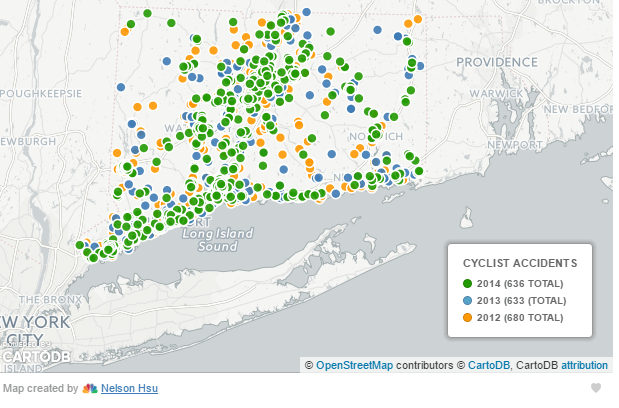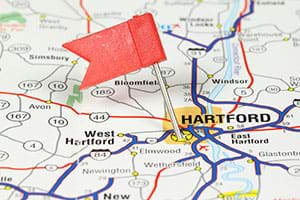This litigation has concluded and we are proud to report that our clients' claims have been successfully resolved. The amounts of all individual client recoveries are confidential, both by settlement agreement and by attorney-client privilege. MLG is no longer accepting cases involving this product.
Statistics regarding cycling crashes in Connecticut are sometimes difficult to locate. Compiling data is often a function of the availability of both human and financial resources to conduct research and assemble the information. A study published in 2009 reported the following statistics for the three-year period from 2005 - 2007:
| Type | 2005 | 2006 | 2007 | Totals |
|---|---|---|---|---|
| Total Bicycle Injury Crashes | 648 | 585 | 667 | 1,900 |
| Bicycle Crash Fatalities | 3 | 5 | 5 | 13 |
Of the 1,900 total bicycle crashes during the three-year period, the majority (between 52% and 61%) occurred on local roads, between 27% and 33% occurred on state roads, and between 11% and 14% occurred on U.S. routes.
The National Highway Traffic Safety Administration (NHTSA) reported 19 bicycle crash fatalities in Connecticut for the three-year period from 2010 - 2012.
A story published by NBC Connecticut in May of 2015 reported on incidents of bicycle accidents in Connecticut over a three-year period from 2012 - 2014. The data acquired for the story from the state Department of Transportation showed New Haven and Hartford as “hot spots” for accidents involving cyclists, with the majority of these accidents occurring at intersections. In New Haven, for example, this data indicated that nearly every intersection within three blocks of the New Haven Green was the site of a bicycle accident over the course of the three-year time span included in this report. The map below plots three years of accidents involving cyclists in Connecticut from 2012 - 2014.

As one would expect, the highest number of bicycle crashes occur in urban areas. For the three-year period of 2005 – 2007, Bridgeport, Hartford and New Haven reported the highest numbers of crashes—each having more than 50 bicycle crashes in any one year during the period. Over the three-year period, 24% of the bicycle crashes in Connecticut occurred in these three urban areas.
The cities of Bristol, Danbury, Manchester, Meriden, New Britain, Norwalk, Stamford, Waterbury, and West Haven reported the next highest totals of bicycle injury crashes during the three-year period. Approximately 27% of all bicycle injury crashes in Connecticut occurred in these nine cities during the three-year period.
 October 2012 study released by the Capitol Region Council of Governments provides data on bicycle crashes occurring in the greater Hartford area over a period of 15 years extending from January of 1995 through January of 2010. Hartford, by far, had the most crashes—833—compared to the next closest total of 311 for Manchester. After that, the towns reporting more than 100 crashes were East Hartford, Enfield, Windsor, and West Hartford. For the towns with the most crashes, the locations with the highest number of crashes were:
October 2012 study released by the Capitol Region Council of Governments provides data on bicycle crashes occurring in the greater Hartford area over a period of 15 years extending from January of 1995 through January of 2010. Hartford, by far, had the most crashes—833—compared to the next closest total of 311 for Manchester. After that, the towns reporting more than 100 crashes were East Hartford, Enfield, Windsor, and West Hartford. For the towns with the most crashes, the locations with the highest number of crashes were:
| Town | Location With the Highest Number of Crashes |
|---|---|
| Hartford | US 44, Albany Avenue, Park Street & Farmington Avenue |
| Manchester | CT Route 83 & US Route 44, Middle Turnpike |
| East Hartford | US 44, Burnside Avenue & US Route 5 |
| Enfield | US Route 5 |
 With certain exceptions, cyclists in Connecticut have all of the same rights and obligations of drivers of vehicles. For example, bicycles are required to have lighting during the same times of day and night that vehicles are required to do so. Bicycles are required to have a headlight (front-facing light) that is white and visible from at least 500 feet away. Rear and side reflectors visible from at least 600 feet away are also required. [Bright rear-facing red lights visible from at least 600 feet away are preferred].
With certain exceptions, cyclists in Connecticut have all of the same rights and obligations of drivers of vehicles. For example, bicycles are required to have lighting during the same times of day and night that vehicles are required to do so. Bicycles are required to have a headlight (front-facing light) that is white and visible from at least 500 feet away. Rear and side reflectors visible from at least 600 feet away are also required. [Bright rear-facing red lights visible from at least 600 feet away are preferred].
Here is a sampling of Connecticut's cycling laws:
In Connecticut, a cyclist's responsibilities/obligations in case of an accident are similar to those of a motor vehicle operator. The cyclist is required to stop, assess injuries, render assistance, and truthfully provide his/her name and address. Here is the text of Section 14-225 of the Connecticut General Statutes:
14-225. Evading responsibility in operation of other vehicles. Any person riding on, propelling, driving or directing any vehicle, except a motor vehicle, on a public street or highway or on any parking area for ten cars or more or on any school property, who has knowledge of having caused injury to the person or property of another and neglects, at the time of the injury, to stop and ascertain the extent of the injury and to render assistance, or refuses to give his name and address, or gives a false name or address when the same is asked for by the person injured or by any other person in his behalf or by a police officer, motor vehicle inspector or constable, shall be fined not more than five hundred dollars or imprisoned not more than six months or both.
In Connecticut, the operator of a vehicle may be liable for double or treble damages if the injured party specifically claims, and a jury finds, that that he/she operated the vehicle deliberately or with reckless disregard. Here is the statute:
Sec. 14-295. Double or treble damages for personal injury or property damage resulting from certain traffic violations. In any civil action to recover damages resulting from personal injury, wrongful death or damage to property, the trier of fact may award double or treble damages if the injured party has specifically pleaded that another party has deliberately or with reckless disregard operated a motor vehicle in violation of section 14-218a, 14-219, 14-222, 14-227a, 14-230, 14-234, 14-237, 14-239 or 14-240a, and that such violation was a substantial factor in causing such injury, death or damage to property. The owner of a rental or leased motor vehicle shall not be responsible for such damages unless the damages arose from such owner's operation of the motor vehicle.
Effective July 1, 2015 Connecticut enacted some important changes to its bicycling law that are designed to provide more protection to cyclists riding on Connecticut roadways and bicycle paths. Among the changes was the amendment of Connecticut General Statutes 14-286b by adding the following section:
Any person operating a bicycle upon a roadway at less than the normal speed of traffic shall ride as close to the right side of the roadway as is safe, as judged by the bicyclist, except when:
- Overtaking or passing another vehicle proceeding in the same direction;
- Preparing for a left turn at an intersection or into a private road or driveway;
- Reasonably necessary to avoid conditions, including, but not limited to, fixed or moving objects, parked or moving vehicles, bicycles, pedestrians, animals, surface hazards or lanes that are too narrow for a bicycle and a motor vehicle to travel safely side by side within such lanes;
- Approaching an intersection where right turns are permitted and there is a dedicated right turn lane, in which case a bicyclist may ride on the left-hand side of such dedicated lane, even if the bicyclist does not intend to turn right;
- Riding on a roadway designated for one-way traffic, when the bicyclist may ride as near to the left-hand curb or edge of such roadway as judged safe by the bicyclist; or
- Riding on parts of roadways separated for the exclusive use of bicycles, including, but not limited to, contra-flow bicycle lanes, left-handed cycle tracks or bicycle lanes on one-way streets and two-way cycle tracks or bicycle lanes.
Here is a list of Connecticut General Statutes applicable to cyclists:
All information and descriptions of state and local (municipal) laws applicable to bicycles, bicyclists and bicycling are intended, and should only be read, as general statements of the applicable rules and laws. This information and these descriptions are not intended to be, and should not be construed or relied upon as being, complete. All such information and descriptions are subject to the existing and complete laws of the state and/or municipality in question, which are subject to change at anytime without notice. None of this information and these descriptions is intended to constitute, or should be construed or relied upon as constituting, legal, medical or other advice of any kind. The providing, and any person’s reading, of this information and these descriptions do not, in any way, create an attorney-client relationship. Such a relationship with The Meneo Law Group, Ron Michael Meneo, LLC and/or MeneoLaw, PLLC can only be created by the consent of both the attorney and the client evidenced by a written retainer or engagement agreement that has been signed by both.
This litigation has concluded and we are proud to report that our clients' claims have been successfully resolved. The amounts of all individual client recoveries are confidential, both by settlement agreement and by attorney-client privilege. MLG is no longer accepting cases involving this product.
2009 Connecticut Statewide Bicycle and Pedestrian Transportation Plan.
http://www.ctbikepedplan.org/documents/CTActiveTransPlan_01-09-2019.pdf
How Safe Is Your Bike Route? The Troubleshooters find and plot three years of cyclist-involved accidents. Story by Christiane Cordero. Map created by Nelson Hsu.
http://www.nbcconnecticut.com/troubleshooters/Troubleshooters-Investigation-Bicycle-Safety-Bike-Route-Dangerous-302276731.html
Pedestrian and Bicycle Crash Study, Capitol Region Council of Governments. October 2012.
http://crcog.org/wp-content/uploads/2016/04/2012_10_12ped_bike_safety_report.pdf